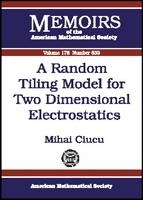
A Random Tiling Model for Two Dimensional Electrostatics
American Mathematical Society (Verlag)
978-0-8218-3794-8 (ISBN)
- Titel ist leider vergriffen;
keine Neuauflage - Artikel merken
The two parts of this Memoir contain two separate but closely related papers. In the paper in Part A we study the correlation of holes in random lozenge (i.e., unit rhombus) tilings of the triangular lattice. More precisely, we analyze the joint correlation of these triangular holes when their complement is tiled uniformly at random by lozenges. We determine the asymptotics of the joint correlation (for large separations between the holes) in the case when one of the holes has side 1, all remaining holes have side 2, and the holes are distributed symmetrically with respect to a symmetry axis.Our result has a striking physical interpretation. If we regard the holes as electrical charges, with charge equal to the difference between the number of down-pointing and up-pointing unit triangles in a hole, the logarithm of the joint correlation behaves exactly like the electrostatic potential energy of this two-dimensional electrostatic system: it is obtained by a Superposition Principle from the interaction of all pairs, and the pair interactions are according to Coulomb's law.The starting point of the proof is a pair of exact lozenge tiling enumeration results for certain regions on the triangular lattice, presented in the second paper. The paper in Part B was originally motivated by the desire to find a multi-parameter deformation of MacMahon's simple product formula for the number of plane partitions contained in a given box. By a simple bijection, this formula also enumerates lozenge tilings of hexagons of side-lengths $a,b,c,a,b,c$ (in cyclic order) and angles of 120 degrees. We present a generalization in the case $b=c$ by giving simple product formulas enumerating lozenge tilings of regions obtained from a hexagon of side-lengths $a,b+k,b,a+k,b,b+k$ (where $k$ is an arbitrary non-negative integer) and angles of 120 degrees by removing certain triangular regions along its symmetry axis. The paper in Part A uses these formulas to deduce that in the scaling limit the correlation of the holes is governed by two dimensional electrostatics.
Part A. A Random Tiling Model for Two Dimensional Electrostatics: Introduction Definitions, statement of results and physical interpretation Reduction to boundary-influenced correlations A simple product formula for correlations along the boundary A $(2m+2n)$-fold sum for $/omega_b$ Separation of the $(2m+2n)$-fold sum for $/omega_b$ in terms of $4mn$-fold integrals The asymptotics of the $T^{(n)}$'s and ${T}^{(n)}$'s Replacement of the $T^{(k)}$'s and ${T}^{(k)}$'s by their asymptotics Proof of Proposition 7.2 The asymptotics of a multidimensional Laplace integral The asymptotics of $/omega_b$. Proof of Theorem 2.2 Another simple product formula for correlations along the boundary The asymptotics of $/bar{/omega}_b$. Proof of Theorem 2.1 A conjectured general two dimensional Superposition Principle Three dimensions and concluding remarks Bibliography Part B. Plane Partitions I: A Generalization of MacMahon's Formula: Introduction Two families of regions Reduction to simply-connected regions Recurrences for $/textup{M}(R_{{/bf1},{/bf q}}(x))$ and $/textup{M}(/bar{R}_{{/bf1},{/bf q}}(x))$ Proof of Proposition 2.1 The guessing of $/textup{M}(R_{{/bf1},{/bf q}}(x))$ and $/textup{M}(/bar{R}_{{/bf1},{/bf q}}(x))$ Bibliography.
| Erscheint lt. Verlag | 1.1.2006 |
|---|---|
| Reihe/Serie | Memoirs of the American Mathematical Society |
| Zusatzinfo | illustrations |
| Verlagsort | Providence |
| Sprache | englisch |
| Gewicht | 312 g |
| Themenwelt | Mathematik / Informatik ► Mathematik ► Angewandte Mathematik |
| Mathematik / Informatik ► Mathematik ► Graphentheorie | |
| Naturwissenschaften ► Physik / Astronomie ► Festkörperphysik | |
| Naturwissenschaften ► Physik / Astronomie ► Thermodynamik | |
| ISBN-10 | 0-8218-3794-X / 082183794X |
| ISBN-13 | 978-0-8218-3794-8 / 9780821837948 |
| Zustand | Neuware |
| Informationen gemäß Produktsicherheitsverordnung (GPSR) | |
| Haben Sie eine Frage zum Produkt? |
aus dem Bereich


